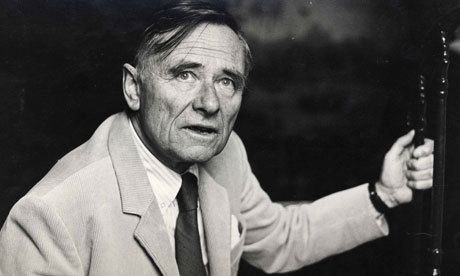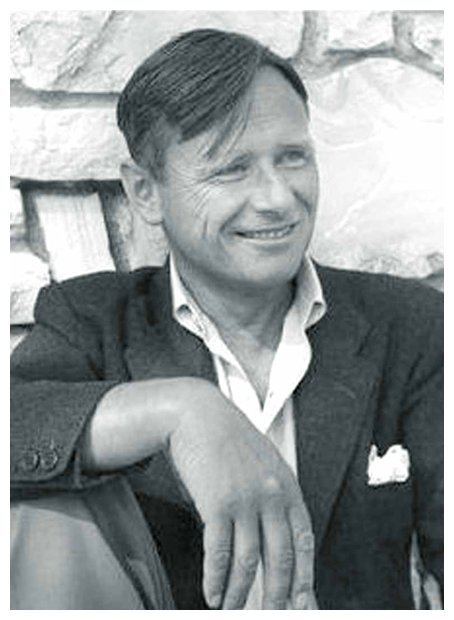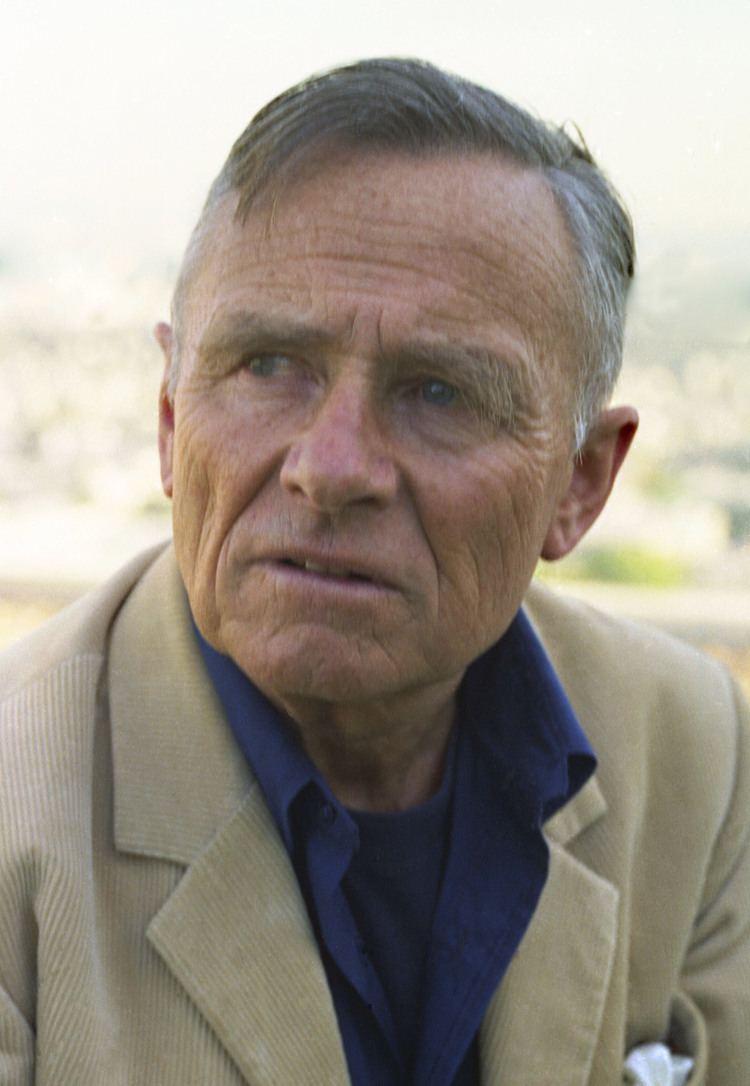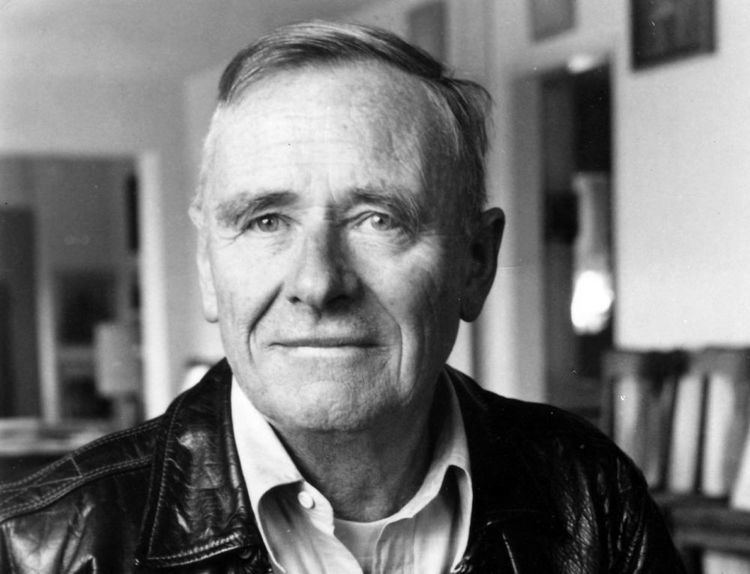Occupation Novelist Name Christopher Isherwood Language English Role Novelist | Siblings Richard Isherwood Alma mater Cambridge University | |
 | ||
Born Christopher William Bradshaw Isherwood26 August 1904Wyberslegh Hall, High Lane, Cheshire, England ( 1904-08-26 ) Citizenship British, American (naturalised) Movies A Single Man, Christopher and His Kind, Cabaret Books Goodbye to Berlin, A Single Man, The Berlin Stories, Mr Norris Changes Trains, Christopher and His Kind Similar People Don Bachardy, W H Auden, John Van Druten, Joe Masteroff, Bob Fosse | ||
Bbc omnibus 1969 christopher isherwood a born foreigner pdtv x264 aac mvgroup forum
Christopher William Bradshaw Isherwood (26 August 1904 – 4 January 1986) was an English-American novelist. His best-known works include The Berlin Stories (1935-39), two semi-autobiographical novellas inspired by Isherwood's time in Weimar Republic Germany. These enhanced his postwar reputation when they were adapted first into the play I Am a Camera (1951), then the 1955 film of the same name, I Am a Camera (film); much later (1966) into the bravura stage musical Cabaret (musical) which was acclaimed on Broadway, its unsparing stance being substantially sweetened for the film Cabaret (1972). His novel A Single Man was published in 1964.
Contents
- Bbc omnibus 1969 christopher isherwood a born foreigner pdtv x264 aac mvgroup forum
- Christopher isherwood 1 of 4 author interviews and film
- Early life and work
- Life in the United States
- Later recognition
- Works
- Work on Vedanta and the West
- Audio and video recordings
- References

Christopher isherwood 1 of 4 author interviews and film
Early life and work

Isherwood was born in 1904 on his family's estate close to the Cheshire-Derbyshire border. He was the elder son of Frank Bradshaw Isherwood, a professional soldier who fought in the Boer War, by his wife Kathleen (née Machell Smith), whose family were successful merchants. Frank Isherwood was the son of John Henry Isherwood, head of the landed gentry family of Isherwood of Marple Hall and Wyberslegh Hall, Cheshire, and a descendant of the regicide John Bradshaw. The Isherwood family estates came into their possession on the marriage of Mary Bradshaw (of the family that had held them for centuries) to Nathaniel Isherwood, a felt-maker from Bolton, Lancashire, in the early 1700s.

At Repton School in Derbyshire, Isherwood met his lifelong friend Edward Upward with whom he wrote the extravagant "Mortmere" stories, of which one was published during his lifetime, a few others appeared after his death, and others he summarised in Lions and Shadows. He deliberately failed his tripos and left Corpus Christi College, Cambridge without a degree in 1925. For the next few years he lived with violinist André Mangeot, worked as secretary to Mangeot's string quartet and studied medicine. During this time he wrote a book of nonsense poems, People One Ought to Know, with illustrations by Mangeot's eleven-year-old son, Sylvain. It was not published until 1982.
In 1925 A.S.T. Fisher reintroduced him to W. H. Auden, and Isherwood became Auden's literary mentor and partner in an intermittent, casual liaison. Auden sent his poems to Isherwood for comment and approval. Through Auden, Isherwood met Stephen Spender, with whom he later spent much time in Germany. His first novel, All the Conspirators, appeared in 1928. It was an anti-heroic story, written in a pastiche of many modernist novelists, about a young man who is defeated by his mother. In 1928–29 Isherwood studied medicine at King's College London, but gave up his studies after six months to join Auden for a few weeks in Berlin.
Rejecting his upper class background and embracing his attraction to men, he remained in Berlin, the capital of the young Weimar Republic, drawn by its reputation for sexual freedom. There, he "fully indulged his taste for pretty youths. He went to Berlin in search of boys and found one called Heinz, who became his first great love." Commenting on John Henry Mackay's Der Puppenjunge (The Pansy), Isherwood wrote: "It gives a picture of the Berlin sexual underworld early in this century which I know, from my own experience, to be authentic."
In 1931 he met Jean Ross, the inspiration for his fictional character, Sally Bowles. He also met Gerald Hamilton, the inspiration for the fictional Mr Norris. In September 1931 the poet William Plomer introduced him to E. M. Forster. They became close and Forster served as his mentor. Isherwood's second novel, The Memorial (1932), was another story of conflict between mother and son, based closely on his own family history. During one of his return trips to London he worked with the director Berthold Viertel on the film Little Friend, an experience that became the basis of his novel Prater Violet (1945). He worked as a private tutor in Berlin and elsewhere while writing the novel Mr Norris Changes Trains (1935) and a short novel called Goodbye to Berlin (1939), often published together in a collection called The Berlin Stories. These works provided the inspiration for the play I Am a Camera (1951), the 1955 film I Am a Camera (both starring Julie Harris), Yes/Buggles' song "Into The Lens/I Am A Camera" (1980), the Broadway musical Cabaret (1966) and the film (1972) of the same name. In 1932 he met and fell in love with a young German man named Heinz Neddermeyer.
After leaving Berlin in 1933, he and Heinz moved around Europe, and lived in Copenhagen, Sintra and elsewhere. Heinz was arrested as a draft-evader in 1937 following his brief return to Germany after he was ejected from Luxembourg as an "undesirable alien." Convicted of "reciprocal onanism", he was sentenced to six months in prison, a year of state labour and two years of compulsory military service. Isherwood collaborated on three plays with Auden: The Dog Beneath the Skin (1935), The Ascent of F6 (1936), and On the Frontier (1939). Isherwood wrote a lightly fictionalized autobiographical account of his childhood and youth, Lions and Shadows (1938), using the title of an abandoned novel. Auden and Isherwood traveled to China in 1938 to gather material for their book on the Sino-Japanese War called Journey to a War (1939). In 1939, Auden and Isherwood set sail for the United States on temporary visas, a controversial move, later regarded by some as a flight from danger on the eve of war in Europe. Evelyn Waugh, in his novel Put Out More Flags (1942), included a caricature of Auden and Isherwood as "two despicable poets, Parsnip and Pimpernel", who flee to America to avoid World War Two.
Life in the United States
While living in Hollywood, California, Isherwood befriended Truman Capote, an up-and-coming young writer who would be influenced by Isherwood's Berlin Stories, most specifically in the traces of the story "Sally Bowles" that surface in Capote's famed novella, Breakfast at Tiffany's.
Isherwood also had a close friendship with the British writer Aldous Huxley, with whom he sometimes collaborated. Gerald Heard had introduced Huxley to Vedanta (Upanishad-centered philosophy) and meditation. Huxley became a Vedantist in the circle of Hindu Swami Prabhavananda, and introduced Isherwood to the Swami's Vedanta circle. Isherwood became a convinced Vedantist himself and adopted Prabhavananda as his own guru, visiting the Swami every Wednesday for the next 35 years and collaborating with him on a translation of the Bhagavad Gita. The process of conversion to Vedanta was so intense that Isherwood was unable to write another novel between the years 1939-1945, while he immersed himself in study of the Vedas.
Isherwood also befriended Dodie Smith, a British novelist and playwright who had also moved to California, and who became one of the few people to whom Isherwood showed his work in progress.
Isherwood considered becoming an American citizen in 1945 but balked at taking an oath that included the statement that he would defend the country. The next year he applied for citizenship and answered questions honestly, saying he would accept non-combatant duties like loading ships with food. The fact that he had volunteered for service with the Medical Corps helped as well. At the naturalization ceremony, he found he was required to swear to defend the nation and decided to take the oath since he had already stated his objections and reservations. He became an American citizen on 8 November 1946.
He began living with the photographer William "Bill" Caskey. In 1947, the two traveled to South America. Isherwood wrote the prose and Caskey took the photographs for a 1949 book about their journey entitled The Condor and the Cows.
On Valentine's Day 1953, at the age of 48, he met teenaged Don Bachardy among a group of friends on the beach at Santa Monica. Reports of Bachardy's age at the time vary, but Bachardy later said, "At the time I was probably 16." In fact, Bachardy was 18. Despite the age difference, this meeting began a partnership that, though interrupted by affairs and separations, continued until the end of Isherwood's life.
During the early months of their affair, Isherwood finished—and Bachardy typed—the novel on which he had worked for some years, The World in the Evening (1954). Isherwood also taught a course on modern English literature at Los Angeles State College (now California State University, Los Angeles) for several years during the 1950s and early 1960s.
The 30-year age difference between Isherwood and Bachardy raised eyebrows at the time, with Bachardy, in his own words, "regarded as a sort of child prostitute," but the two became a well-known and well-established couple in Southern Californian society with many Hollywood friends.
Down There on a Visit, a novel published in 1962, comprised four related stories that overlap the period covered in his Berlin stories. In the opinion of many reviewers, Isherwood's finest achievement was his 1964 novel A Single Man, that depicted a day in the life of George, a middle-aged, gay Englishman who is a professor at a Los Angeles university. During 1964 Isherwood collaborated with American writer Terry Southern on the screenplay for the Tony Richardson film adaptation of The Loved One, Evelyn Waugh's caustic satire on the American funeral industry.
Isherwood and Bachardy lived together in Santa Monica for the rest of Isherwood's life. Bachardy became a successful artist with an independent reputation, and his portraits of the dying Isherwood became well known after Isherwood's death.
Isherwood died at age 81 in 1986 in Santa Monica, California. His body was donated to science at UCLA, and his ashes were later scattered at sea.
Later recognition
Works
Translations:
Work on Vedanta and the West
Vedanta and the West was the official publication of the Vedanta Society of Southern California. It offered essays by many of the leading intellectuals of the time and had contributions from Aldous Huxley, Gerald Heard, Alan Watts, J. Krishnamurti, W. Somerset Maugham, and many others. Isherwood was Managing Editor from 1943 until 1945. Together with Huxley and Heard, he served on the Editorial Advisory Board from 1951 until 1962.
Isherwood wrote the following articles that appeared in Vedanta and the West:
In 1948 several articles from Vedanta and the West were issued in book form as Vedanta for the Western World. Isherwood edited the selection and provided an introduction and three articles ("Hypothesis and Belief," "Vivekananda and Sarah Bernhardt," "The Gita and War"). Other contributors included Aldous Huxley, Gerald Heard, Swami Prabhavananda, Swami Vivekananda et al.
